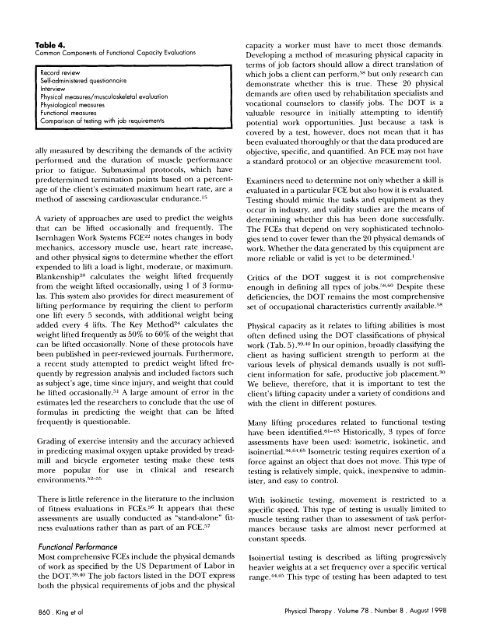A Critical Review of Functional Capacity ... - Physical Therapy
A Critical Review of Functional Capacity ... - Physical Therapy
A Critical Review of Functional Capacity ... - Physical Therapy
You also want an ePaper? Increase the reach of your titles
YUMPU automatically turns print PDFs into web optimized ePapers that Google loves.
Table 4.<br />
Common Components <strong>of</strong> <strong>Functional</strong> <strong>Capacity</strong> Evaluations<br />
-<br />
Record review<br />
Self-administered questionnaire<br />
Interview<br />
<strong>Physical</strong> measures/musculoskeletal evaluation<br />
Physiological measures<br />
<strong>Functional</strong> measures<br />
Comparison <strong>of</strong> testing with iob requirements<br />
ally ~neasured by describing the demands <strong>of</strong> the activity<br />
performed and the duration <strong>of</strong> muscle performance<br />
prior to fatigue. Submaximal protocols, which have<br />
predetermined termination points based on a percent-<br />
age <strong>of</strong> the client's estirrlated maximum heart rate, are a<br />
method <strong>of</strong> assessing cardiovascular endurance.15<br />
A variety <strong>of</strong> approaches are used to predict the weights<br />
that can be lifted occasionally and frequently. The<br />
Isernhagen Work Systems FCE" notes changes in body<br />
mechanics, accessory muscle use, heart rate increase,<br />
and other physical signs to determine whether the effort<br />
expended to lift a load is light, moderate, or maxirnuni.<br />
Blankenship" calculates the weight lifted frequently<br />
from the weight lifted occasionally, using 1 <strong>of</strong> 3 formulas.<br />
This system also provides for direct measurement <strong>of</strong><br />
lifting performance by requiring the client to perform<br />
one lift every 5 seconds, with additional weight being<br />
added every 4 lifts. The Key Meth~d*~ calculates the<br />
weight lifted frequently as 50% to 60% <strong>of</strong> the weight that<br />
can be lifted occasionally. None <strong>of</strong> these protocols have<br />
been published in peer-reviewed journals. Furthermore,<br />
a recent study attempted to predict weight lifted frequently<br />
by regression analysis and included factors such<br />
as subject's age, time since injury, and weight that could<br />
be lifted occa~ionally.~ A large amount <strong>of</strong> error in the<br />
estimates led the researchers to conclude that the use <strong>of</strong><br />
formulas in predicting the weight that can be lifted<br />
frequently is questionable.<br />
Grading <strong>of</strong> exercise intensity and the accuracy achieved<br />
in predicting maximal oxygen uptake provided by tread-<br />
mill and bicycle ergometer testing make these tests<br />
more popular for use in clinical and research<br />
There is little reference in the literature to the inclusion<br />
<strong>of</strong> fitness evaluations in FCES.~~ It appears that these<br />
assessments are usually conducted as "stand-alone" fitness<br />
evaluations rather than as part <strong>of</strong> an FCE.57<br />
<strong>Functional</strong> Performance<br />
Most comprehensive FCEs include the physical demands<br />
<strong>of</strong> work as specified by the US Department <strong>of</strong> Labor in<br />
the DOT.8R40 The job factors listed in the DOT express<br />
both the physical requirements <strong>of</strong>jobs and the physical<br />
860 . King et a1<br />
capacity a worker must have to meet those demands.<br />
Developing a method <strong>of</strong> measuring physical capacity in<br />
terms <strong>of</strong> job factors should allow a direct translation <strong>of</strong><br />
which jobs a client can perform," but only research can<br />
demonstrate whether this is true. These 20 physical<br />
demands are <strong>of</strong>ten used by rehabilitation specialists and<br />
vocational counselors to classify jobs. The DOT is a<br />
valuable resource in initially attempting to identify<br />
potential work opportunities. Just because a task is<br />
covered by a test, however, does not mean that it has<br />
been evaluated thoroughly or that the data produced are<br />
objective, specific, and quantified. An FCE may not have<br />
a standard protocol or an objective measurement tool.<br />
Examiners need to determine not only whether a skill is<br />
evaluated in a particular FCE but also how it is evaluated.<br />
Testing should mimic the tasks and equipment as they<br />
occur in industry, and validity studies are the means <strong>of</strong><br />
determining whether this has been done successfully.<br />
The FCEs that depend on very sophisticated technolo-<br />
gies tend to cover fewer than the 20 physical demands <strong>of</strong><br />
work. Whether the data generated by this equipmerlt are<br />
more reliable or valid is yet to be determined.'<br />
Critics <strong>of</strong> the DOT suggest it is not comprehensive<br />
enough in defining all types <strong>of</strong> job^.^^.^^ Despite these<br />
deficiencies, the DOT remains the most comprehensive<br />
set <strong>of</strong> occupational characteristics currently a~ailable.~~<br />
<strong>Physical</strong> capacity as it relates to lifting abilities is most<br />
<strong>of</strong>ten defined using the DOT classifications <strong>of</strong> physical<br />
work (Tab. 5) ."z40 In our opinion, broadly classifjing the<br />
client as having sufficient strength to perform at the<br />
various levels <strong>of</strong> physical demands usually is not suffi-<br />
cient information for safe, productive job placement.")<br />
We believe, therefore, that it is important to test the<br />
client's lifting capacity under a variety <strong>of</strong> conditions and<br />
with the client in different postures.<br />
Many lifting procedures related to functional testing<br />
have been ide~ztified."-fj~ Historically, 3 types <strong>of</strong> force<br />
assessments have been used: isometric, isokinetic, and<br />
i~oinertial.~~,~~.6~ Isometric testing requires exertion <strong>of</strong> a<br />
force against an object that does not move. This type <strong>of</strong><br />
testing is relatively simple, quick, inexpensive to administer,<br />
and easy to control.<br />
With isokinetic testing, movement is restricted to a<br />
specific speed. This type <strong>of</strong> testing is usually limited to<br />
muscle testing rather than to assessment <strong>of</strong> task perfor-<br />
mances because tasks are almost never performed at<br />
constant speeds.<br />
Isoinertial testing is described as lifting progressively<br />
heavier weights at a set frequency over a specific vertical<br />
range.44.GThis type <strong>of</strong> testing has been adapted to test<br />
<strong>Physical</strong> <strong>Therapy</strong> . Volume 78 . Number 8 . August 1998
















